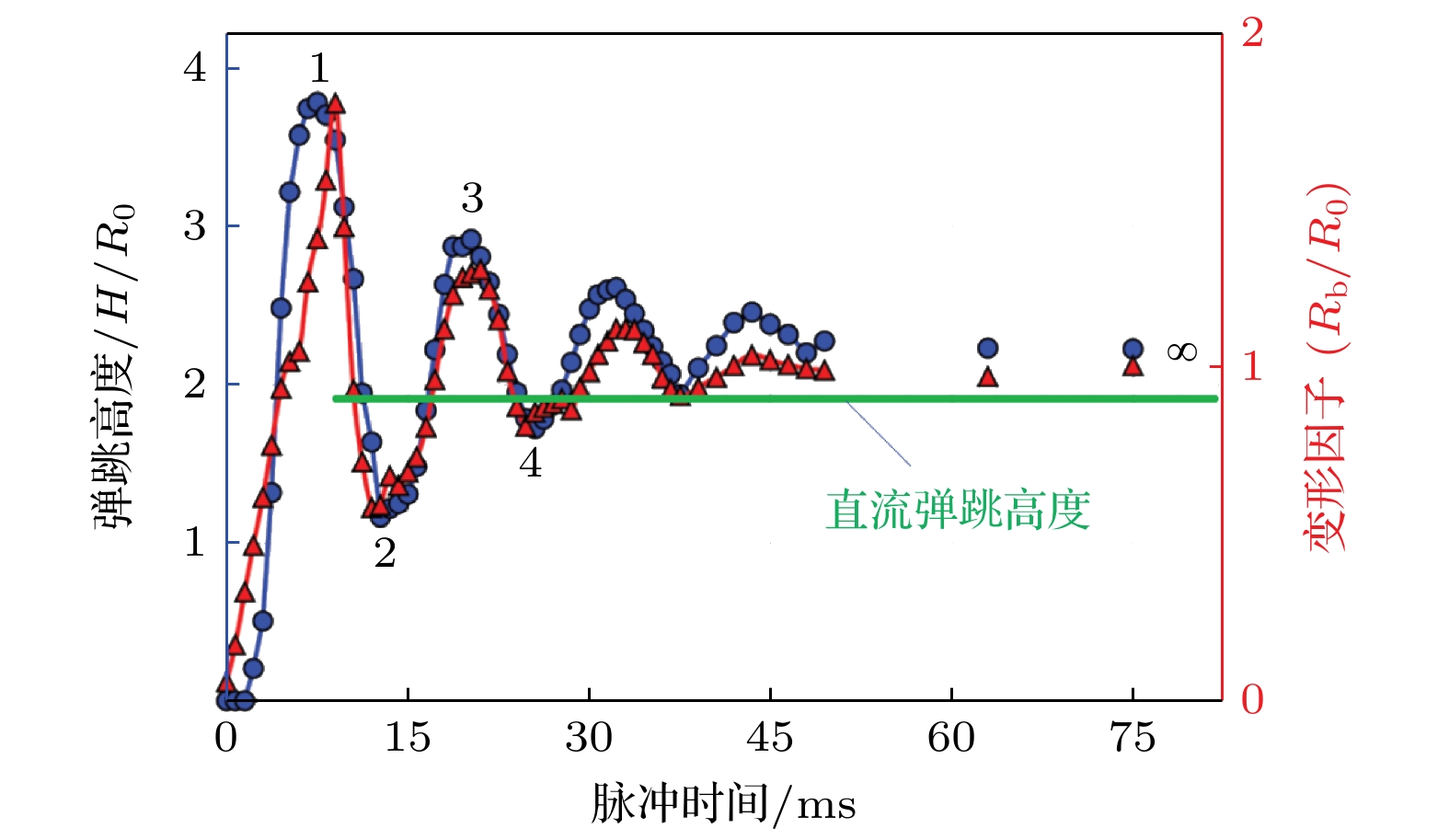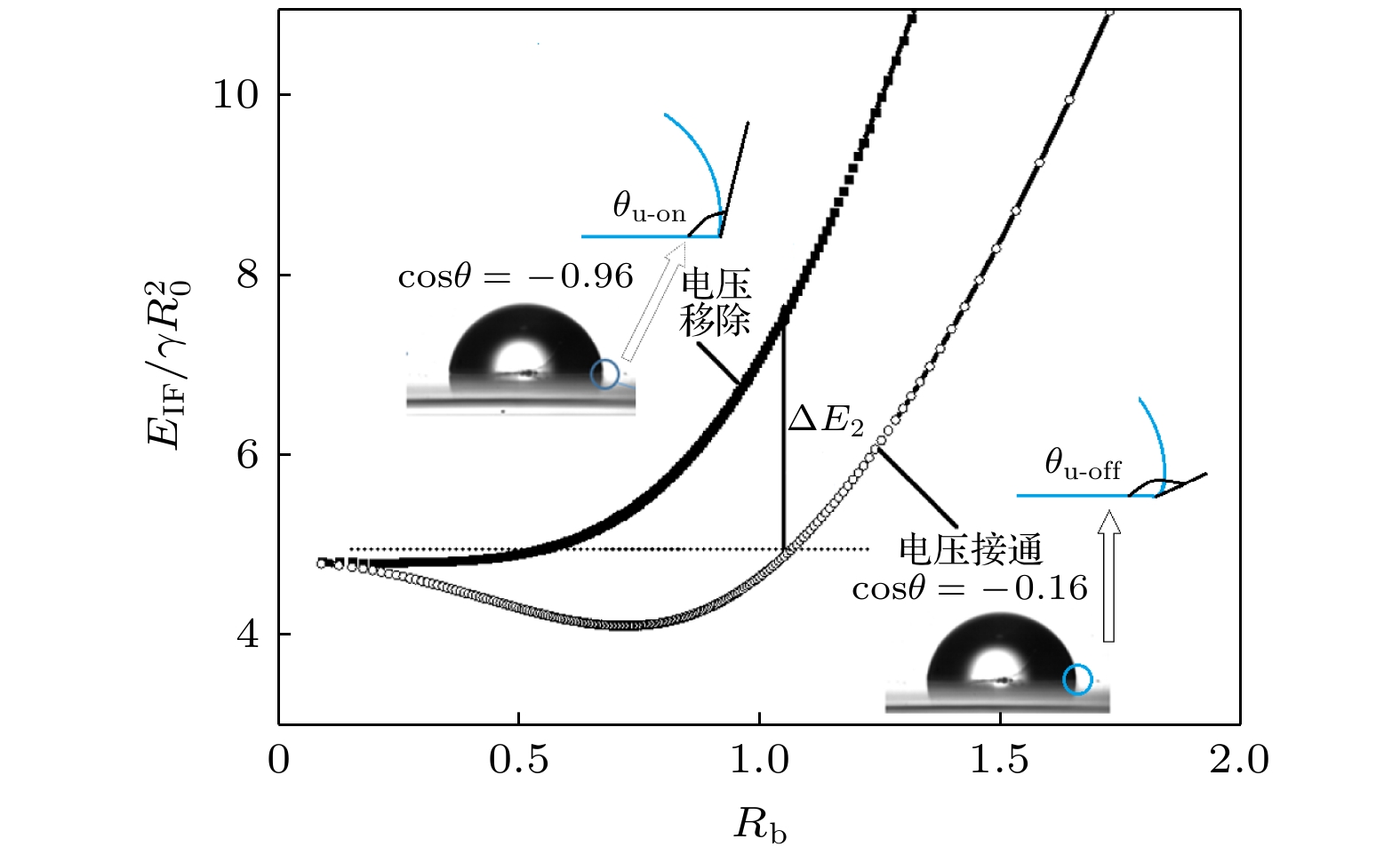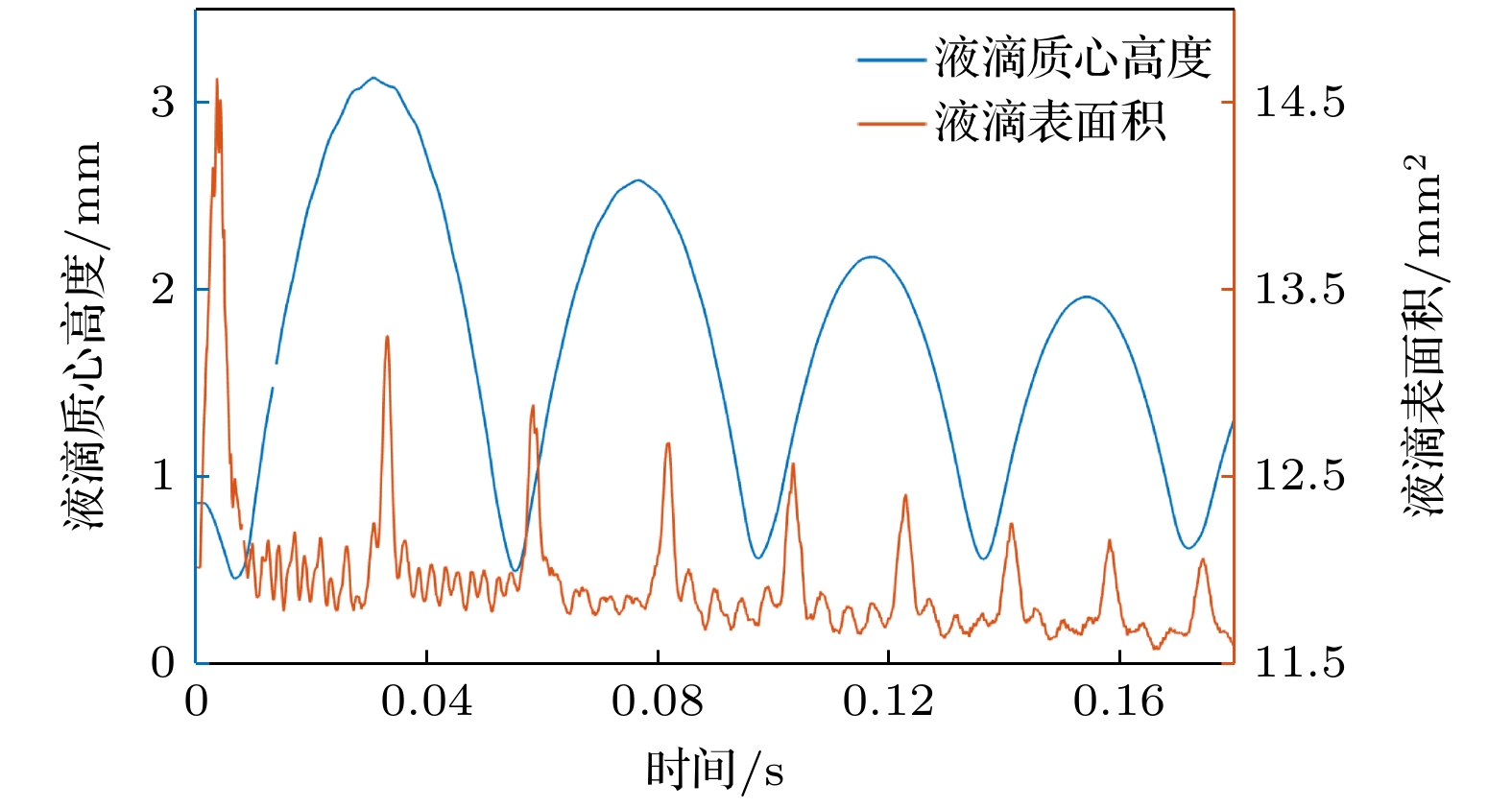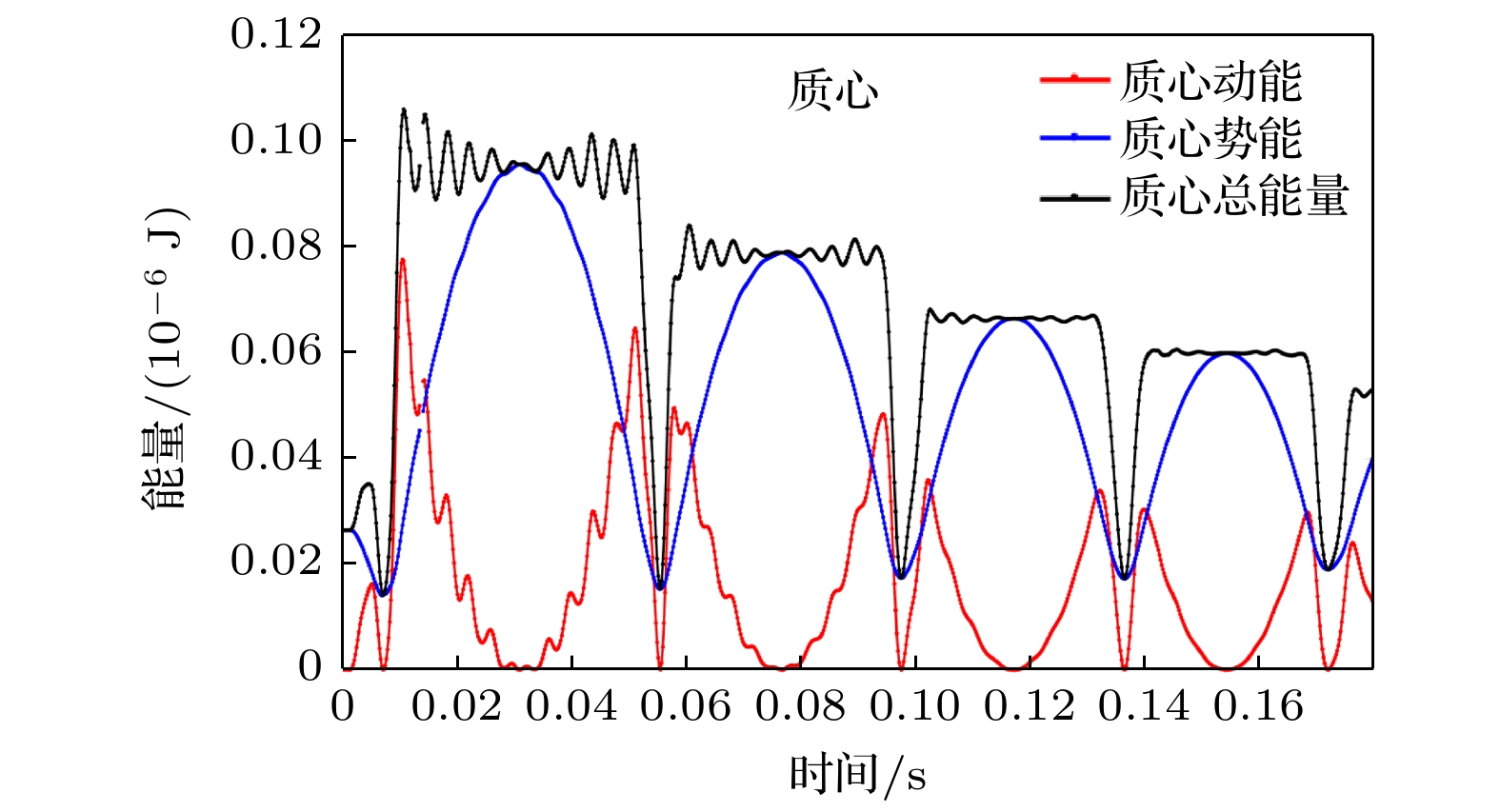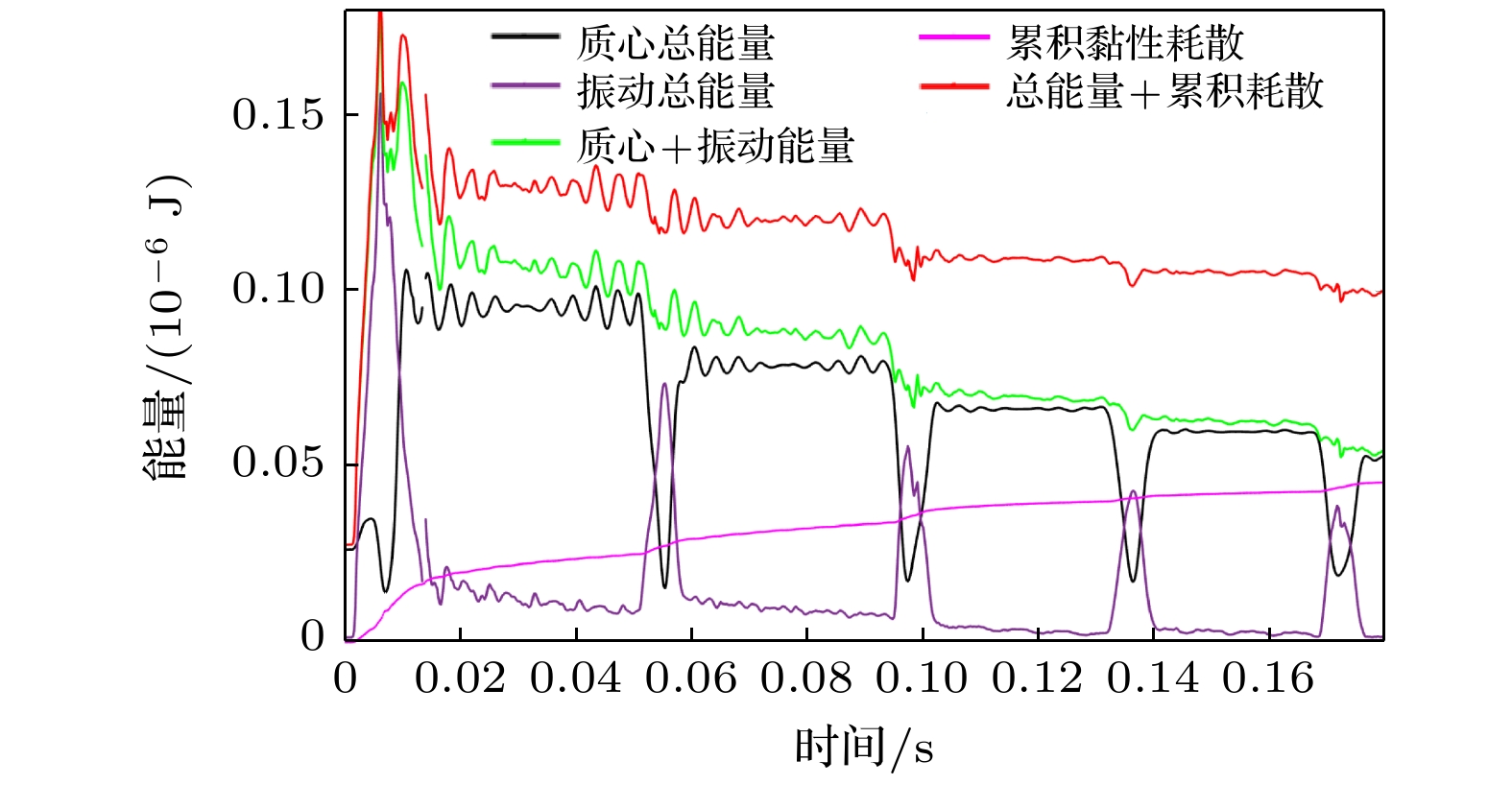-
许多工业技术如凝结散热和燃料电池等要求实现固液分离, 电润湿是引发液滴从疏水表面脱离的一种有效的方法, 而且方便控制. 电场激励的液滴弹跳依赖于表面能向动能和其他形式能量的转化, 目前尚缺乏对这一过程的深入研究. 本研究利用高速摄像机捕捉了在电润湿激励下疏水表面液滴的弹跳运动, 根据接触角和液滴形态的变化预估了引发液滴弹跳的电压阈值, 并利用自编Matlab程序分析和计算了在液滴脱离表面和反复弹跳过程中各种形式的能量. 结果表明, 液滴质心的动能和势能在液滴脱离表面飞行期间存在明显的耦合关系, 振动动能和表面势能在飞行阶段也存在一定的耦合关系, 液滴黏性引起的内部耗散随着液滴振荡变形的幅度增大, 并随着时间衰减. 由于可以引发液滴振荡变形并制造更多的表面能, 在液滴弹跳中交流脉冲比直流电更高效. 通过揭示电润湿驱动的液滴弹跳过程中能量的转化和耗散机制, 为该技术在固液分离和三维数字微流控中的应用提供了理论参考.Many industrial technologies, such as condensation cooling and fuel cells, require solid-liquid separation. Electrowetting is a very effective method of inducing droplets to detach from hydrophobic surfaces, and it is very convenient to control. The jumping of droplets excited by an electric field depends on the conversion of surface energy into kinetic energy and other forms of energy. At present, there is still a lack of in-depth research on this process. In this study, a high-speed camera is used to capture the jumping motion of a droplet on a hydrophobic surface under the actuation of electrowetting, and the threshold voltage that causes the droplet to detach is estimated based on the changes in contact angle and droplet shape. A self-written Matlab program is used to analyze and calculate the various forms of energy in the process of droplets detaching and subsequent bouncing. The results show that there is an obvious coupling relationship between the kinetic energy and potential energy of the droplet’s center of mass during the flight of the droplet from the surface. The vibrational kinetic energy and surface potential energy also show a certain coupling relationship during the flight phase. The internal dissipation caused by the viscosity of the droplet increases with the droplet oscillation amplitude increasing, and decays with time. Because it can cause the droplet to oscillate and deform and create more surface energy, AC pulses are more efficient than direct current in the droplet bounce. By revealing the energy conversion and dissipation mechanism in the process of droplet jumping driven by electrowetting, a theoretical reference is provided for the application of this technology in solid-liquid separation and three-dimensional digital microfluidics.
-
Keywords:
- electrowetting /
- jumping /
- energy /
- conversion /
- dissipation
[1] 毕菲菲, 郭亚丽, 沈胜强, 陈 觉先, 李熠桥 2012 物理学报 61 184702
 Google Scholar
Google Scholar
Bi F F, Guo Y L, Shen S Q, Chen J X, Li Z J 2012 Acta Phys. Sin. 61 184702
 Google Scholar
Google Scholar
[2] Lin S, Zhao B, Zou S, Guo J, Wei Z, Chen L 2018 J. Colloid Interf. Sci. 516 86
 Google Scholar
Google Scholar
[3] Schutzius T M, Jung S, Maitra T, Graeber G, Köhme M, Poulikakos D 2015 Nature 527 82
 Google Scholar
Google Scholar
[4] Palan V, Shepard W S 2006 J. Power Sources 159 1061
 Google Scholar
Google Scholar
[5] 姚朝晖, 钟麟彧 2016 第九届全国流体力学学术会议论文摘要集 中国南京 2016年10月21—23日
Yao Z H, Zhong L Y 2016 Abstract Collection of Papers of the 9 th National Conference on Fluid Mechanics Nanjing, China, October 21–23, 2016 (in Chinese)
[6] Boreyko J B, Chen C H 2010 Phys. Fluids 22 091110
 Google Scholar
Google Scholar
[7] Enright R, Miljkovic N, Sprittles J, Nolan K, Mitchell R, Wang E N 2014 ACS Nano 8 10352
 Google Scholar
Google Scholar
[8] Li X, Jiang Y, Jiang Z, Li Y, Wen C, Lian J 2019 Appl. Surf. Sci. 492 349
 Google Scholar
Google Scholar
[9] Pinchasik B E, Wang H, Möhwald H, Asanuma H 2016 Adv. Mater. Inter. 3 1600722
 Google Scholar
Google Scholar
[10] Baratian D, Dey R, Hoek H, Ende D V D, Mugele, F 2018 Phys. Rev. Lett. 120 214502
 Google Scholar
Google Scholar
[11] Lee S J, Lee S, and Kang K H 2011 J. Visual. 14 259
 Google Scholar
Google Scholar
[12] Raman K A, Jaiman R K, Lee T S, Low H T 2016 Int. J. Heat Mass Tran. 99 805
 Google Scholar
Google Scholar
[13] Wang Z, Ende D V D, Pit A M, Lagraauw R, Wijnperlé D, Mugele F 2017 Soft Matter. 13 4856
 Google Scholar
Google Scholar
[14] Hong J, Kim Y K, Won D J, Kim J, Lee, S J 2015 Sci. Rep. 5 1
[15] Mugele F, Baret J C 2005 J. Phys. Cond. Matter 17 R705
 Google Scholar
Google Scholar
[16] Vallet M, Berge B, Vovelle L 1996 Polymer 37 2465
 Google Scholar
Google Scholar
[17] Cho S K, Moon H, Kim C J 2003 J. Microelectromechanical Sys. 12 70
 Google Scholar
Google Scholar
[18] Li J, Kim C J 2020 Lab Chip 20 1705
 Google Scholar
Google Scholar
[19] Zhang K X, Li Z, Chen S 2019 Phys. Fluids 31 081703
 Google Scholar
Google Scholar
[20] Vo Q, Tran T 2019 Phys. Rev. Lett. 123 024502
 Google Scholar
Google Scholar
[21] Wang Q G, Xu M, Wan C, Gu J P, Hu N, Lyu J F, Yao W 2020 Langmuir 36 8152
 Google Scholar
Google Scholar
[22] Burkhart C T, Maki K L, Schertzer M J 2020 Langmuir 36 8129
 Google Scholar
Google Scholar
[23] Torkkeli, A 2003 Ph. D. Dissertation (Helsinki: VTT Technical Research Centre of Finland)
[24] Yi U C, Kim C J 2006 J. Micromech. Microeng. 16 2053
 Google Scholar
Google Scholar
[25] Cavalli A, Preston D J, Tio E, Martin D W, Miljkovic N, Wang E N, Miljkovic F, Bush J W M 2016 Phys. Fluids 28 866
[26] 周建臣, 耿兴国, 林可君, 张永建, 臧渡洋 2014 物理学报 63 216801
 Google Scholar
Google Scholar
Zhou J C, Geng X G, Lin K J, Zhang Y J, Zang D Y 2014 Acta Phys. Sin. 63 216801
 Google Scholar
Google Scholar
[27] Oh J M, Ko S H, Kang K H 2008 Langmuir 24 8379
 Google Scholar
Google Scholar
[28] Lee J, Park J K, Hong J, Lee S J, Kang K H, Hwang H J 2014 Phys. Rev. E 90 033017
 Google Scholar
Google Scholar
[29] Moláček J, Bush J W M 2012 Phys. Fluids 24 127103
 Google Scholar
Google Scholar
[30] Thoraval M J, Thoroddsen S T 2013 Phys. Rev. E 88 061001
 Google Scholar
Google Scholar
[31] De Ruiter J, Lagraauw R, Van Den Ende D, Mugele F 2015 Nat. Phys. 11 48
 Google Scholar
Google Scholar
-
图 5 液滴在电润湿作用下界面能(空心圆圈)以及移除电压以后的界面能(实心方块), Rb 代表液滴球缺的底面半径. 两条曲线上相同的Rb对应的两点具有同样的形状, 同一条曲线上不同的点具有相同的固-液界面张力
${\gamma }_{\rm SL}$ . 注意液滴的界面能和底面半径均经过了无量纲处理Fig. 5. The interfacial energies of the droplet under electrowetting (open circles) and after removing the voltage (solid squares), the X-axis represents the base radius of the droplet. The same abscissa (Rb) represents the same droplet shape, and different points on the same curve have the same solid-liquid interfacial tension. Note that both the interfacial energy and base radius of the droplet are dimensionless.
图 7 液滴在弹跳过程中质心能量随时间的变化, 其中液滴质心的动能(红色)和势能(蓝色)是分别结合实验数据利用方程(10)和(11)计算得出, 质心的质心总能量(黑色)是以上两部分的总和
Fig. 7. Variation of the droplet centroid energy with time during the bouncing process. The kinetic energy (red) and potential energy (blue) of the droplet are calculated using Eqs. (10) and (11) based on experimental data, respectively, and the total energy (black) of the centroid is the sum.
图 8 液滴的振动能量转化图谱, 其中振动动能(粉色)和振动势能(蓝绿)分别是结合实验数据利用方程(13)和(15)计算得出, 液滴的振动总能量(紫色)是以上两部分之和
Fig. 8. Vibrational energy conversion spectrum of droplet. The vibrational kinetic energy (pink) and vibrational potential energy (blue-green) are calculated using Eqs. (13) and (15) based on experimental data, respectively. The total vibrational energy (purple) of the droplet is the sum.
-
[1] 毕菲菲, 郭亚丽, 沈胜强, 陈 觉先, 李熠桥 2012 物理学报 61 184702
 Google Scholar
Google Scholar
Bi F F, Guo Y L, Shen S Q, Chen J X, Li Z J 2012 Acta Phys. Sin. 61 184702
 Google Scholar
Google Scholar
[2] Lin S, Zhao B, Zou S, Guo J, Wei Z, Chen L 2018 J. Colloid Interf. Sci. 516 86
 Google Scholar
Google Scholar
[3] Schutzius T M, Jung S, Maitra T, Graeber G, Köhme M, Poulikakos D 2015 Nature 527 82
 Google Scholar
Google Scholar
[4] Palan V, Shepard W S 2006 J. Power Sources 159 1061
 Google Scholar
Google Scholar
[5] 姚朝晖, 钟麟彧 2016 第九届全国流体力学学术会议论文摘要集 中国南京 2016年10月21—23日
Yao Z H, Zhong L Y 2016 Abstract Collection of Papers of the 9 th National Conference on Fluid Mechanics Nanjing, China, October 21–23, 2016 (in Chinese)
[6] Boreyko J B, Chen C H 2010 Phys. Fluids 22 091110
 Google Scholar
Google Scholar
[7] Enright R, Miljkovic N, Sprittles J, Nolan K, Mitchell R, Wang E N 2014 ACS Nano 8 10352
 Google Scholar
Google Scholar
[8] Li X, Jiang Y, Jiang Z, Li Y, Wen C, Lian J 2019 Appl. Surf. Sci. 492 349
 Google Scholar
Google Scholar
[9] Pinchasik B E, Wang H, Möhwald H, Asanuma H 2016 Adv. Mater. Inter. 3 1600722
 Google Scholar
Google Scholar
[10] Baratian D, Dey R, Hoek H, Ende D V D, Mugele, F 2018 Phys. Rev. Lett. 120 214502
 Google Scholar
Google Scholar
[11] Lee S J, Lee S, and Kang K H 2011 J. Visual. 14 259
 Google Scholar
Google Scholar
[12] Raman K A, Jaiman R K, Lee T S, Low H T 2016 Int. J. Heat Mass Tran. 99 805
 Google Scholar
Google Scholar
[13] Wang Z, Ende D V D, Pit A M, Lagraauw R, Wijnperlé D, Mugele F 2017 Soft Matter. 13 4856
 Google Scholar
Google Scholar
[14] Hong J, Kim Y K, Won D J, Kim J, Lee, S J 2015 Sci. Rep. 5 1
[15] Mugele F, Baret J C 2005 J. Phys. Cond. Matter 17 R705
 Google Scholar
Google Scholar
[16] Vallet M, Berge B, Vovelle L 1996 Polymer 37 2465
 Google Scholar
Google Scholar
[17] Cho S K, Moon H, Kim C J 2003 J. Microelectromechanical Sys. 12 70
 Google Scholar
Google Scholar
[18] Li J, Kim C J 2020 Lab Chip 20 1705
 Google Scholar
Google Scholar
[19] Zhang K X, Li Z, Chen S 2019 Phys. Fluids 31 081703
 Google Scholar
Google Scholar
[20] Vo Q, Tran T 2019 Phys. Rev. Lett. 123 024502
 Google Scholar
Google Scholar
[21] Wang Q G, Xu M, Wan C, Gu J P, Hu N, Lyu J F, Yao W 2020 Langmuir 36 8152
 Google Scholar
Google Scholar
[22] Burkhart C T, Maki K L, Schertzer M J 2020 Langmuir 36 8129
 Google Scholar
Google Scholar
[23] Torkkeli, A 2003 Ph. D. Dissertation (Helsinki: VTT Technical Research Centre of Finland)
[24] Yi U C, Kim C J 2006 J. Micromech. Microeng. 16 2053
 Google Scholar
Google Scholar
[25] Cavalli A, Preston D J, Tio E, Martin D W, Miljkovic N, Wang E N, Miljkovic F, Bush J W M 2016 Phys. Fluids 28 866
[26] 周建臣, 耿兴国, 林可君, 张永建, 臧渡洋 2014 物理学报 63 216801
 Google Scholar
Google Scholar
Zhou J C, Geng X G, Lin K J, Zhang Y J, Zang D Y 2014 Acta Phys. Sin. 63 216801
 Google Scholar
Google Scholar
[27] Oh J M, Ko S H, Kang K H 2008 Langmuir 24 8379
 Google Scholar
Google Scholar
[28] Lee J, Park J K, Hong J, Lee S J, Kang K H, Hwang H J 2014 Phys. Rev. E 90 033017
 Google Scholar
Google Scholar
[29] Moláček J, Bush J W M 2012 Phys. Fluids 24 127103
 Google Scholar
Google Scholar
[30] Thoraval M J, Thoroddsen S T 2013 Phys. Rev. E 88 061001
 Google Scholar
Google Scholar
[31] De Ruiter J, Lagraauw R, Van Den Ende D, Mugele F 2015 Nat. Phys. 11 48
 Google Scholar
Google Scholar
计量
- 文章访问数: 9646
- PDF下载量: 100
- 被引次数: 0
















 下载:
下载:


